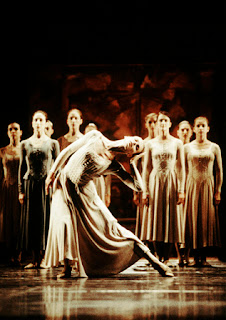Last night, my husband and I saw the "Summer Mixed Rep" program at the Houston Ballet, consisting of two world premieres, Zodiac by Stanton Welch and The Letter V by Mark Morris, and a returning piece from choreographer Jirí Kylián titled Svadebka, which premiered in the Netherlands in 1982 and was performed by the Houston Ballet in 2007.
The first piece was Zodiac by Stanton Welch, a world premiere set to new music by Ross Edwards commissioned especially for this piece. I really hope that a recording of this music will eventually be available, because it was gorgeous and I would buy it in a heartbeat. It was sophisticated and dramatic, and it created a unique musical "signature" for each of the twelve signs, which couldn't have been easy. (The Houston Ballet En Pointe blog has a brief interview with Mr. Edwards here.)
So, twelve movements, each representing one of the zodiac signs -- what an irresistible concept! And it was simply stunning. You would think that with twelve short movements, each lasting only 3-4 minutes, that they would all run together in a blur, but they really didn't. Several of the movements stood out in particular, but there wasn't a single one I didn't like. The piece started quietly, with the only sound coming from the slowly pounding feet of twelve helmeted ancient warriors against a backdrop of stars and a stylized eclipse. A woman came forward to remove one dancer's helmet, and the individual movements began with Aries. Each movement featured a male dancer with the astrological sign painted on his chest, and, except for Libra, differing numbers of additional male and female dancers, with several signs conveyed by a pas de deux. The piece ended in reverse, with the woman replacing the warrior's helmet, once again to the sound of stomping feet.
My favorite movements were Aries, in which first soloist Aaron Robison performed a series of breathtaking turns that went on for an impossible length of time; Gemini, which incorporated a certain amount of mischievousness in the twins' leaps and turns around each other; and Aquarius, in which the steps at times gave the impression of running waters. I loved Eduardo Sicangco's costumes, which like the music were unique for each sign. (Go here for another Houston Ballet blog post about the costume designer. This sketch, and the photograph at the top of this post, show the concept design and the finished costume for Taurus, danced by Madeline Skelly.) I should also mention the lighting design by Lisa J. Pinkham, something one doesn't always notice in a dance production. Again, it was unique for each sign, and very striking, especially the patterns on the floor that changed for each movement.
The second piece, Svadebka by choreographer Jirí Kylián, was wildly different from Zodiac, which is the beauty of mixed rep programs. I felt like I was seeing a Russian-wedding-slash-Amish-barnraising during which dancers from Fiddler on the Roof and West Side Story appeared on the scene. And I mean that in the best possible way! This piece was odd, with dramatic music by Igor Stravinsky including vocals by the Houston Chamber Choir, but it was rich and beautiful and I didn't want it to end. It's a wedding, but is it a happy occasion? Is it arranged? The bride (Jessica Collado) seems reluctant at times, and the mother (Katherine Precourt) seems to project a tragic inevitability, but is that because of the specific union, or because this community is in the depths of poverty or even war? I don't mind not knowing; regardless of specifics, I came away from this piece feeling the energy and earthiness of it.
Unfortunately, the Mark Morris piece, The Letter V, did not quite work for me. The music, Symphony No. 88 in G Major by Joseph Haydn, was gorgeous, but it was also sedate, and there just wasn't a lot of energy or intricate steps or even visual interest to keep the audience engaged. I also felt the costumes were distracting. When the first ballerina appeared in what looked to be a green and black striped leotard with a flowing cream-colored chiffon (I'm guessing) overlay, I thought that it was pretty. But when three other female dancers appeared in the same costume, the stripes began to overwhelm, and it was made worse when the male dancers joined them. That group was eventually joined by four more pairs wearing what looked like green and black checked gingham, which was also puzzling.
To be fair, the dancing in this piece was still lovely, and it probably suffered unfairly in comparison to the two previous pieces. I've seen other work by this choreographer, who is critically acclaimed and rightly so. This piece just didn't click for me; I couldn't feel inspired because I couldn't see it as inspired.
Overall, it was a wonderful evening, and every time I see a mixed rep program, I begin to suspect that I secretly prefer them to the full-length ballets. I think what I actually like the best is classical technique mixed into contemporary dance, and I certainly feel like I got that here. I'm going back to see it again at tomorrow's Sunday matinee; I can't wait to see what nuances I missed the first time around.
And just to prove how subjective this all is, I just found this review in the New York Times, which comes to the exact opposite conclusions that I do! The reviewer, Alastair Macauley, knows orders of magnitude more about ballet than I do, while all I can do is comment on what I do and don't like. For that reason, I don't read other reviews until after I've written my own, but I like to read them then because I can learn from them.
All images property of the Houston Ballet.
Saturday, June 6, 2015
Subscribe to:
Post Comments (Atom)









No comments:
Post a Comment